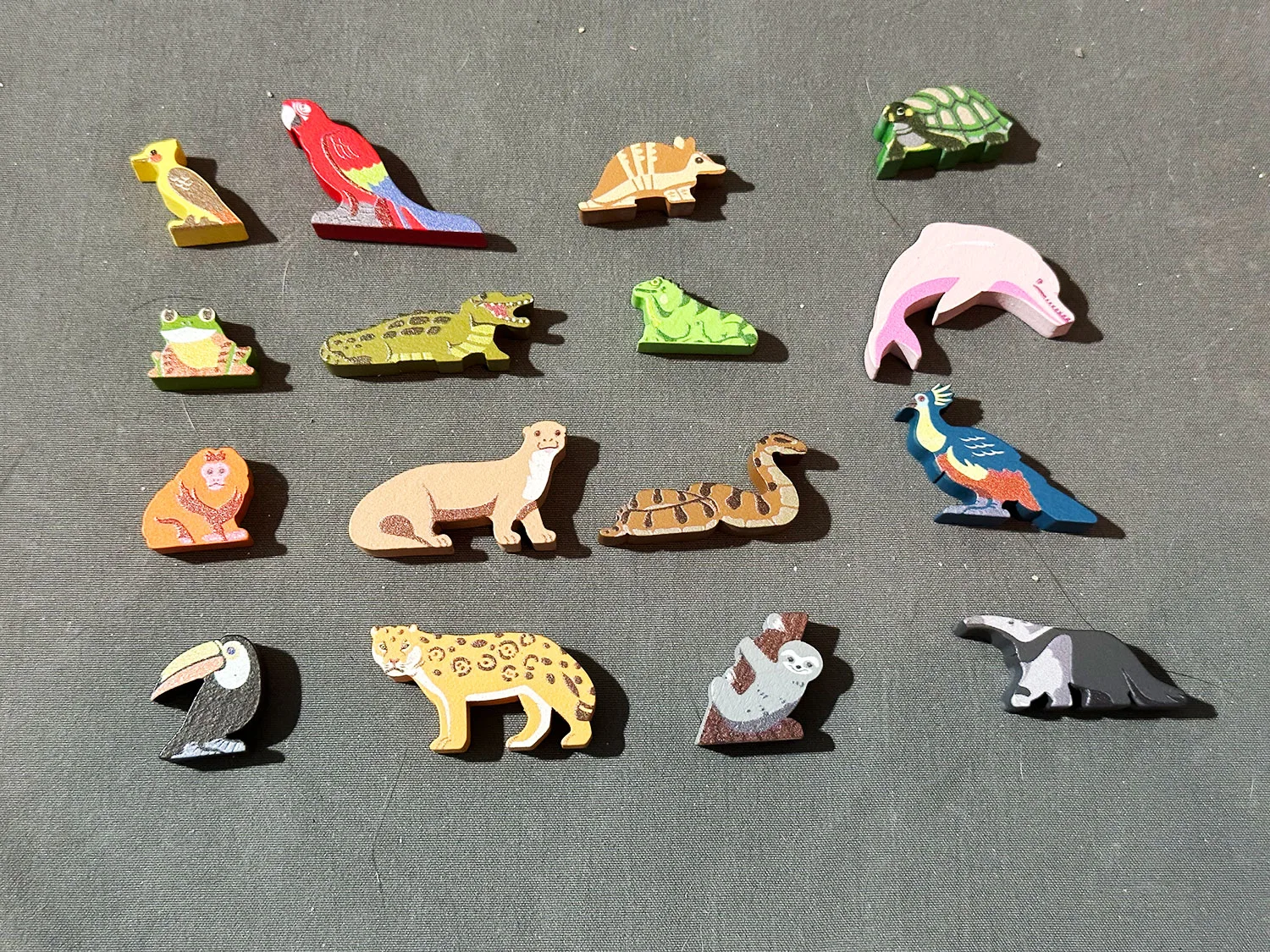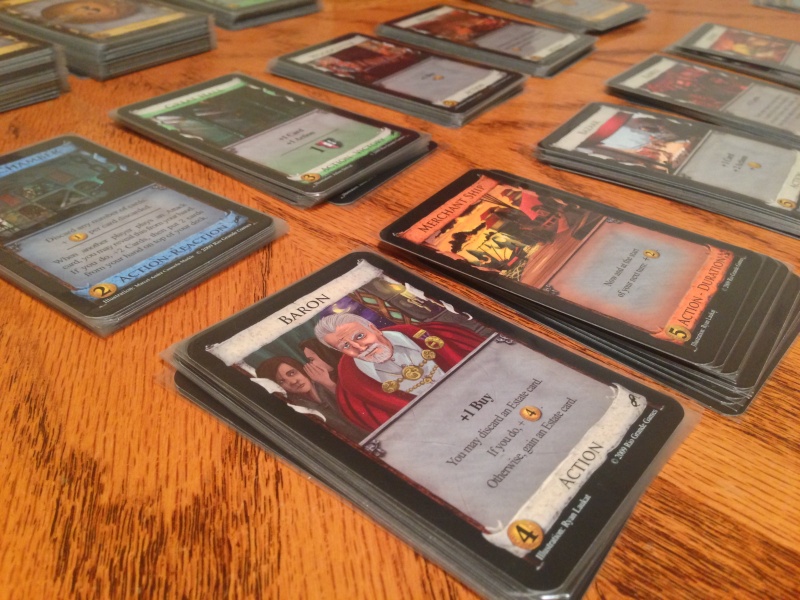 Every good game needs a sequel. When you have a game based on cute little ani-meeples, what better way to make a sequel than going to a completely different ecosystem. That’s what Life of the Amazonia fulfills… it is the psuedo-sequel to Wild: Serengeti, complete with its own set of animals inspired by the Amazon. But a game is not solely defined by its predecessors or its components. The gameplay needs to stand on its own, so let’s take a look. Life of the Amazonia is a game for 1-4 players and it plays in 1-2 hours.
Every good game needs a sequel. When you have a game based on cute little ani-meeples, what better way to make a sequel than going to a completely different ecosystem. That’s what Life of the Amazonia fulfills… it is the psuedo-sequel to Wild: Serengeti, complete with its own set of animals inspired by the Amazon. But a game is not solely defined by its predecessors or its components. The gameplay needs to stand on its own, so let’s take a look. Life of the Amazonia is a game for 1-4 players and it plays in 1-2 hours.
Gameplay Overview:
Though I say this game is a sequel to Wild: Serengeti, it is more like the next in a series that shares similar components and aesthetics. The gameplay is actually quite different. Instead of trying to move animals around into certain configurations, this is primarily about building a vibrant and diverse jungle. This is achieved through bag building. Each player starts with a bag of 10 tokens and, similar to a deck-building game, draws 5 of them per turn. These starting tokens provide limited resources but can get you started getting more tokens, and more specifically, getting you the right kind of tokens. There are four types—Currency, Leaves, Water, and Fruits—with each type being available in a value from 1 to 4. Each type has a different use and you’ll need all of them in varying degrees to add different aspects to your jungle.

The game has very little concept of rounds, just player turns. On your turn, you can spend the resources on your tokens drawn for the turn (as well as a limited amount you can save from your previous turn) to complete as many actions as you want or can afford. Then, play passes to the next player who does the same, and so on until the 5 of the 8 available animals in the supply are depleted, which marks the final turns of the game. The ways you can spend your resources are varied, and the different resources are used only for specific things. You can buy the 8 basic animals to add to your jungle, buy additional (and higher value) tokens of the four types, buy foliage for your jungle, and/or buy special nature cards to help your score, among a few other possibilities.
Once enough animal supplies are depleted, you tally up your scores, and the highest score wins (essentially representing the most diverse and vibrant jungle!). Achieving a higher score requires taking advantage of the various available actions. Each animal has its own scoring rules, the nature scene cards can direct you toward utilizing certain animals for a bigger score, and the nature critter cards give helpful bonuses to get you there. The different scoring requirements on animals will often tie into the trees and aquatic flowers that you buy throughout the game. Finally, each player has a Unique Animal that they pick at the start of the game, which can also help guide your strategy.

Game Experience:
To get this out of the way right from the start, if there is one hit against this game, it would be that to an extent it really feels like everyone is just in their lanes, doing there thing, and there isn’t a whole lot of interaction. That’s not to say there is none, because seeing what an opponent is doing and potentially trying to cut them off from getting animals that would be beneficial to them is certainly a thing, but there is not a lot of player interaction. Some may view that as a good thing (in this case, I do), but it may be a problem for some as well.

That out of the way, the most obvious area this game shines is in its table presence. There is a Waterfall of Life made out of folded punchboard that tracks everyone’s trees, aquatic flowers, and jungle size, which by itself looks neat on the table while also keeping that information easily accessible and readable. The animal meeples themselves look as good as you might expect, though they are smaller than the ones in Wild: Serengeti. Given the savannah is known for megafauna, and the jungle typically has smaller life, this does make sense. There are also a lot of meeples here. I was surprised by the sheer number. One final note on this: there are upgrades available to also get the other components (tokens, trees, flowers) in the same material as the meeples, rather than punchboard, and it only enhances how gorgeous it looks.
Beyond that, I find the gameplay to be entertaining. I did enjoy Wild: Serengeti, and this feels like a step up from that. There was a tendency in that game for animals to occasionally feel scarce (which is a shame in a game all about the animal meeples!). That isn’t really the case here, as you can end up packing quite a few animals into your jungle, and it only accelerates as the game goes on. It does have a certain amount of buildup. One of the keys to the game is understanding when to be bag-building (i.e., adding to and upgrading your tokens), and when to be just buying animals and expanding your jungle. Once you master feeling out when that is, and you switch over to buying things almost exclusively, seeing the rapid expansion of everyone’s jungles is fun in and of itself.

For a game that is largely pretty light-feeling, there is a decent amount of strategy that goes into it. Achieving a high score requires a balance across the various aspects of a jungle, typically. You want to do well on all three of the tracks on the Waterfall of Life, as there are bonuses for your placement on each. You also want to take advantage of the ability offered by your Unique Animal, and try to maximize the points you can get from scene cards. All while balancing against the scoring requirements of each of the 8 Basic Animals. It can be a bit of a juggling act. It ends up being fun usually, succeed or fail. Even a low-scoring jungle can be fun to assemble and see at the end of the game.
One of the things that held back Wild: Serengeti a bit was the game could potentially get a little long at its static 6 rounds. This rectifies this a bit, as it is not quite so structured. The game takes however many turns it takes to empty out 5 of the Basic Animals. This can be a little slow-going at first, but as your purchasing power grows, the amount of animals being bought rapidly accelerates and the game concludes before it overstays its welcome. In a way, it is similar to a game of Dominion in this regard, which feels like a good game to be compared to favorably!

Final Thoughts:
Of the recent animal-themed games the last few years, Life of the Amazonia one has moved to near the top of the list for me. It isn’t as complex as a game like Ark Nova, but it has enough complexity to be interesting after many plays, and doesn’t really get stale due to the inherent variability. I enjoyed Wild: Serengeti despite some of the flaws I’d outline in the review I did on it, but this is a better game overall. It isn’t a perfect game, but it is a good and fun one that I’m willing to play whenever someone asks.
It does seem like they have learned from a few of the things that held back Wild: Serengeti, which I am happy to see. The different options here all seem to be potentially balanced. Starting out a game with a specific Unique Animal versus another doesn’t seem to be an inherent disadvantage or an advantage.
The production value on the meeples (and overall) with this line continues to be great. The smaller size of the meeples in this one might be a little off-putting if one is familiar with the huge, chonky meeples from Wild: Serengeti, but outside that comparison, they hold up pretty good against similar games, and no other games are as cute, which is by far the most important metric. I am optimistic about a follow. Personally, I’m hoping for Australia, because everyone needs koala and platypus meeples in their life.
Final Score: 4 Stars – Like its spiritual predecessor the game is cute and fun with great ani-meeples, but fixing some of the first game’s issues and offering greater depth.
 Hits:
Hits:
• Again, the ani-meeples are adorable, and are the main attraction.
• The look of the jungles at the end of the game is impressive.
• The gameplay has a lot going on, and thus a lot of strategic depth, but is easy to understand.
Misses:
• Low player interaction, though this may be seen as a pro.
• There are a lot of variables, and it can be easy to forget something and therefore miss a big scoring opportunity.
• Currency has a limited shelf life. Till you really master when to switch completely over to buying, it is very easy to overload yourself with it.






















